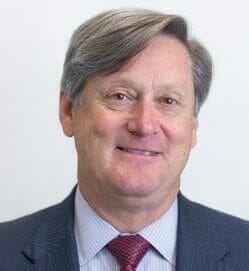
Bill Dombi, president of the National Association for Home Care & Hospice, on Sunday night once again slammed the Centers for Medicare & Medicaid Services’ proposed home health rule, which carries a severe behavioral assumption adjustment of -7.69% related to the recently enacted Patient-Driven Groupings Model.

“They have violated the law with no semblance of logic to make this a budget-neutral transition,” Dombi told the crowd on the first night of the association’s Financial Management Conference in Las Vegas.
The proposed rule would reduce payments by 4.2%, or $810 million, in calendar year 2023. Such a rule is “shaking the foundation of all home health services,” he told the audience in the exhibit hall at Caesars Palace.
He exhorted members to express to CMS in comments how the rule might affect their bottom lines. He outlined the three fronts the association is working on to combat the rule: through regulatory comments, which are due in the middle of next month; through legislation, which is expected to be introduced in Congress Monday; and through possible litigation.
“We’ve got the action plan in play now,” he said.
Workforce
Dombi addressed other key advocacy issues for NAHC. The most important one is the workforce shortage, he said.
“There are an untold number of people from the baby boomer generation who are going to be in need of services in the near future and we don’t have the people to deliver that care,” he said.
He noted that the association can take any number of steps to work through the proposed Medicare cut, such as suing CMS or changing a law.
“Unless we have the staff, it really doesn’t matter,” he said.
There is not one solution, he said. He pointed to compensation, career opportunities, family caregiver supports, technologies, supply of personnel, and image and respect as areas to improve.
Another key issue for the association is to address the poor rates that Medicare Advantage, which he called the “darling of Congress,” pays to home health agencies.
“We have to find a way to deal with the plans who are not recognizing the value that’s there in what you do,” he said.
Legislation
Dombi also talked about certain pieces of legislation on NAHC’s radar. They include the bill formerly known as Build Back Better, which would include substantial funding for workforce solutions. While the legislation will come back, it will not be this year, he said. He was also bullish on Choose Home, a bill that would provide a new Medicare benefit for post-acute patients who are deemed clinically appropriate for home recovery. Legislation is moving in the House and Senate it said. Passage this year also is unlikely, but strong allies such as AARP, make passage possible.
“We have to be persistent in making it happen,” he said.
He was most optimistic about passage of the HEAT (Home Health Emergency Access to Telehealth) Act, which would remove barriers to Medicare paying for telehealth services.
“Its destiny is absolutely there,” Dombi said.
Among its other advocacy efforts, the association is throwing its weight behind a community palliative care benefit. CMS has indicated a favorable reaction to it, he said.
“It’s much more than end-of-life services,” he noted.
Dombi offered some closing remarks on trends in home care. These include privatization of Medicare, the horizontal integration of healthcare at home (an agency that offers several types of services) and the continuum of care moving from a specific setting to various settings. He pointed to massive insurance companies buying home health agencies and Amazon acquiring a primary care company as examples of this trend taking shape.
“This is not a fad,” he said. “It’s absolutely happening.”


